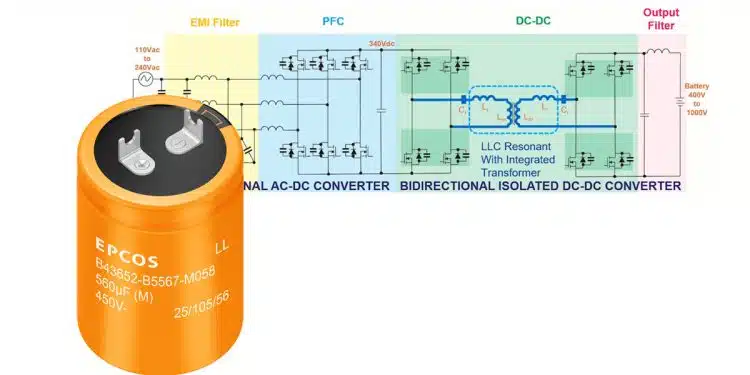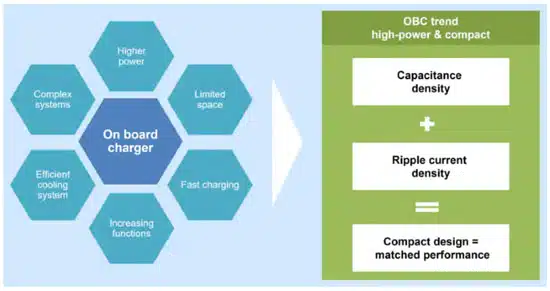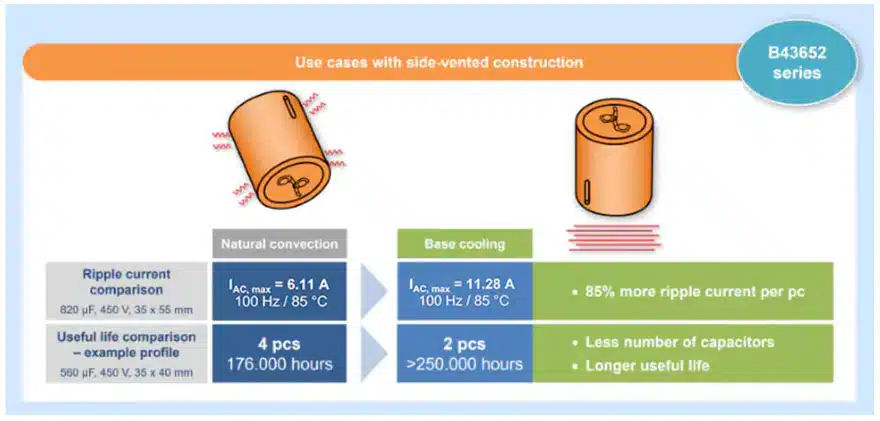TDK application note discusses use and benefits of aluminum electrolytic capacitors for DC link in on-board charger applications.
With the increasing market for electrified vehicles (EVs), the demand for on-board chargers (OBCs) is growing fast. OBCs open up the possibility to charge the car not only at fast-charging DC stations but also with AC sources in a reasonable time. Such systems are currently going up to 22 kW with operating voltages up to 800 V.
The function of the OBC is to convert the AC voltage from an external source to a specific DC voltage that is based on the requirements of the battery management system. By this, a battery-saving and fast charging process can be reached. Especially in remote areas without sufficient fast DC charging infrastructure, OBCs are essential to make EVs more attractive.
Due to the complexity of such systems, the OBC needs a certain bulk capacitance to stabilize the DC voltage that is charging the battery. Aluminum electrolytic capacitors are an attractive solution here since they can fulfill the key requirements, such as high voltage ratings of up to 500 V, large capacitance of up to 820 µF and high ripple current capabilities at an operating temperature range of -40 °C to 105 °C.
Challenges for aluminum electrolytic capacitors in on-board chargers
The DC link capacitor does not only have to fulfil the capacitance requirements of the system, but it also must withstand the continuously increasing ripple currents since the power densities of the OBCs are steadily rising.
As a result, higher power losses appear that heat up the complete system which can cause performance degradation and reduced lifetime. Therefore, being competitive inevitably requires a cooling system that is also connected to the DC link capacitors.
To cover these requirements, TDK developed the new large-size series B43652* for OBC applications that is optimized for base cooling and perfectly combines all of the above-mentioned characteristics.
The reason for thermal management
The right choice of the DC link capacitor depends on several parameters. The rated voltage (VR) results from the operating voltage of the OBC and shall cover the average plus peak ripple voltage. For systems >500 V, in series connected capacitors can be considered. The rated ripple current IR, the required lifetime and the operating temperature range arise from the mission profile of the OBC. The operating temperature range shall cover the expected ambient temperatures across the complete service life.
While some requirements are given and can hardly be changed, some characteristics can be optimized either by the supplier or the customer. The lifetime of an aluminum electrolytic capacitor is mainly influenced by its core temperature. Generally said, high ripple currents and increased ambient temperatures heat up the capacitor significantly and therefore reduce the lifetime.
Based on the Arrhenius equation as a rule of thumb, one can consider a lifetime reduction of 50% when increasing the core temperature by 10 K. To reduce core temperatures under the same load conditions, the ESR of the component can be reduced and the thermal management can be optimized. With the B43652* series, TDK developed a large-size capacitor that has both a very low ESR and an improved internal thermal resistance across the full lifetime.
With an external cooling system providing an efficient heat transfer between the capacitor’s can bottom and the heatsink, customers can get the maximum out of these capacitors, i.e. a high ripple current capability for a significantly increased lifetime. From an economic point of view, such optimizations are always to be preferred compared to using either more capacitors in parallel or capacitor designs with longer rated lifetime.
Inner design in the context of capacitor cooling
The inside of an aluminum electrolytic capacitor contains a winding element that naturally has a much higher thermal conductivity in the axial than in the radial direction. To gain a base cooling option, this thermal conductivity in the axial direction was further improved for the B43652 series of compact snap-in aluminium capacitors.
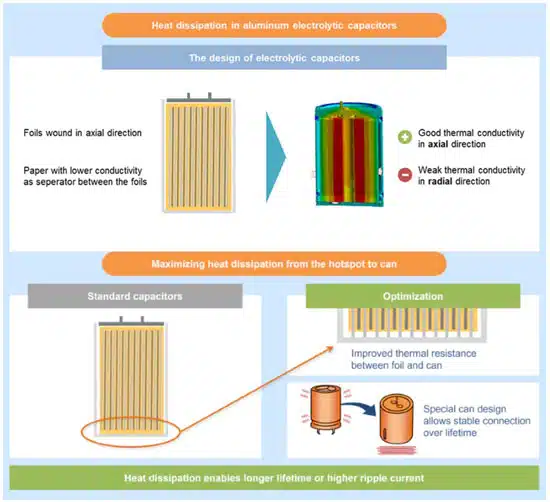
A direct metal contact between the winding element and the can bottom decreases the thermal resistance from hotspot to can and the improved stability of the can bottom itself avoids bulging over lifetime that would impair this thermal connection. As the bottom side of the capacitor usually contains a pressure relief vent that a heatsink would block, it was shifted to the side wall of the capacitor. Overall, the new B43652 series of TDK is a side-vented large-size capacitor targeting OBC applications with a base-cooling option.

The improvement of these design changes can be seen in Figure 4. For a standard 35 x 40 mm capacitor the internal thermal resistance in the axial direction is 4.49 K/W while it is reduced to 0.6 K/W for the improved side-vented design of the B43652 series. The overall thermal resistance from core to ambient is also reduced by 20% from 15.1 K/W to 12 K/W due to the metal contact between the winding element and the can bottom.
In Figure 5, a comparison of thermal simulations (temperature and heat flux) of the bottom-vented design with natural connection (left) and the side-vented design with base cooling (right) is presented.
When applying 1 W per capacitor at 85 °C ambient temperature, a core temperature of 106 to 109 °C is reached for the non-cooled version.
Looking at the same scenario with the side-vented design and a base cooling, considering a heatsink temperature of 85 °C, the core temperature of the capacitors is increased only by 3 K to 88 °C. This is approximately 20 K lower than the non-cooled design and means a lifetime increase of roughly 200%.
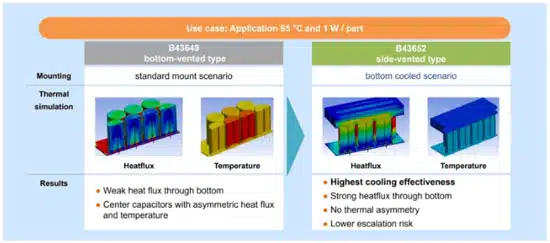
Comparing the heat flux simulations, it is visible that the base-cooled scenario transfers heat mainly via the can bottom. A gradient in the axial direction can be seen, presenting weak heat transfer on the PCB side and strong heat transfer on the bottom side.
The non-cooled version presents a gradient in the other direction, heat transfer mainly happens in the direction of the PCB. Hence, the non-cooled design shows a weak heat flux through the bottom side and besides this also an asymmetric heat flux for the center capacitors.
Further, while the non-cooled version displays a spread across the core temperatures, which means a thermal asymmetry with center capacitors having higher core temperatures, the base-cooled version does not have such a spread, resulting in a significantly reduced escalation risk.
The overall improvements that can be reached in an OBC application are presented in Figure 6. Comparing two B43652 capacitors of the same size, rated voltage and rated capacitance, the base-cooled capacitor can withstand 85% more ripple current than the same design with just natural convection.
While the capacitor with natural convection reaches a maximum ripple current IAC,max of 6.11 A, the base-cooled version reaches 11.28 A. Furthermore, for the same load conditions, two base-cooled capacitors can withstand the mission profile almost two times longer than four non-cooled capacitors.
Based on these results, it is clearly evident that TDK’s large-size capacitors of B43652* series are optimized for OBC applications with a base cooling option and can significantly reduce the number of pieces in the DC-link capacitor bank, making this series not only technically but also economically interesting.



















